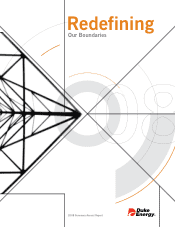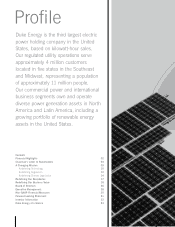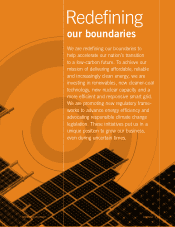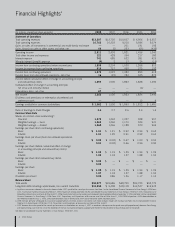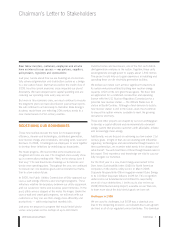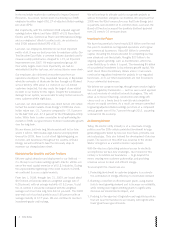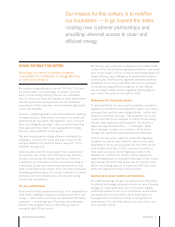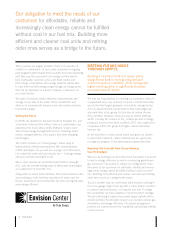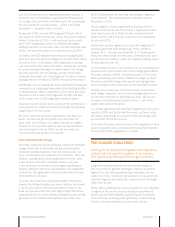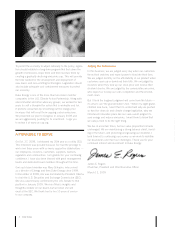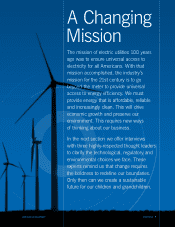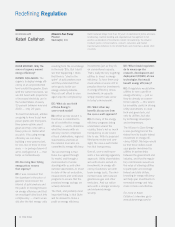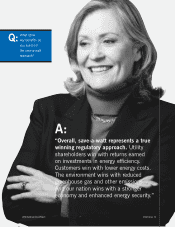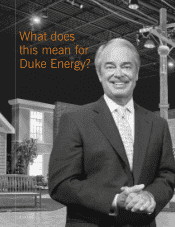Duke Energy 2008 Annual Report Download - page 9
Download and view the complete annual report
Please find page 9 of the 2008 Duke Energy annual report below. You can navigate through the pages in the report by either clicking on the pages listed below, or by using the keyword search tool below to find specific information within the annual report.
2008 Summary Annual Report Duke Energy 7
Just over 50 percent of our regulated generation capacity is
fueled by coal. In the Midwest, approximately 95 percent of
our energy sales come from coal-fired assets. We are building
two new advanced coal-fired plants — about a $5 billion
investment — to replace older coal units.
At year-end 2008, the new 825-megawatt Cliffside Unit 6
coal project in North Carolina was nearly 30 percent complete.
When it is finished in 2012, it will eventually replace more
than 1,000 megawatts of older, less efficient and higher-
emitting coal units. As we retire older coal units and take other
actions, we expect this plant to be carbon-neutral by 2018.
In Indiana, the 630-megawatt Edwardsport coal gasification
plant was about 20 percent complete at year-end 2008. When
finished in 2012, it will replace 160-megawatts of existing
coal units built in the 1940s and 1950s. Importantly, we hope
to use developing technology for carbon capture and storage
near this plant site. We are seeking a portion of the funds
authorized for cleaner coal technologies in the federal stimulus
package enacted in February 2009 for this part of the project.
Additionally, we are building two lower-emitting 620-megawatt
combined cycle natural gas-fired plants at two existing facilities
in North Carolina. When completed in 2012, these new units
will retire a total of about 250 megawatts of older coal-fired
units as part of the 1,000 megawatts referenced above.
Baseload coal and nuclear power plants are the workhorses of
power generation. Unlike wind and solar power, they typically
supply power 24 hours a day.
By 2013, when we will have completed our two new coal
plants, the two new gas-fired plants and shut down the
older units, we will reduce our carbon intensity by roughly
10 percent. If we proceed with the new Lee Nuclear Station
and can bring it on line by 2020, we will have reduced
our carbon intensity by about 20 percent.
Advancing Renewable Energy
Our utility companies are increasing the amount of renewable
energy in their mix to meet both existing and anticipated
renewable portfolio standards. Over the last two years, we
have issued requests for proposals in the Carolinas, Ohio and
Indiana, seeking bids for power generated from solar, wind,
water, biomass and other renewable sources. Last year,
a new wind farm in northern Indiana began supplying our
Indiana customers with up to approximately 100 megawatts
of electricity. Our agreement to receive power from this wind
farm extends for 20 years.
To ensure that power from a growing number of new wind
farms in the Midwest reaches our service territory, we formed
a 50-50 joint venture with American Electric Power to site,
build and operate a 240-mile ultra-high-voltage 765-kilovolt
transmission line in Indiana. Besides linking new and existing
generation in the northern and southern parts of the state,
the $1 billion project will also help alleviate grid congestion
in the Midwest. The earliest possible completion date for
the project is 2015.
We also signed a 20-year agreement to purchase the full
output of what will be one of the nation’s largest photovoltaic
solar farms to be built in North Carolina. Construction will
begin in 2009, and the facility is expected to be operational
by year-end 2010.
Additionally, we have agreed to purchase five megawatts of
electricity generated from methane gas from a landfill in
Durham, N.C., and one near Greenville, S.C. Producing elec-
tricity from methane gas not only uses a renewable fuel, but it
also destroys the methane, which has a global warming impact
20 times greater than CO2.
On the commercial side of our business, we are expanding into
biopower with a joint venture with French energy giant AREVA.
This new company, ADAGE, will develop plants in the United
States powered by wood waste. AREVA will design and build
the plants, and Duke Energy will operate and manage them.
We are aiming to start construction on the first plant in 2010.
Over the last several years, Commercial Power acquired two
wind energy companies, and last year we began operations at
our first two wind farms in Wyoming and Texas. We are also
co-owner of the Sweetwater project in Texas — one of the
largest wind farms in the world.
In a unique agreement with Wal-Mart, beginning in the second
quarter of 2009 and for the next four years, our Texas facility
will supply wind energy for a portion of the total energy used
by more than 350 stores in Texas.
At the end of last year, we had close to 400 megawatts of wind
power in operation and a potential wind development pipeline
of more than 5,000 megawatts in 14 states.
THE CLIMATE CHALLENGE:
Pushing for the approval of legislative and regulatory
policies that will ease the transition to an industry
with significantly fewer greenhouse gas emissions.
Long-term investors know that we see climate change as
one of our nation’s greatest challenges. I believe we need to
regulate CO2 and other greenhouse gas emissions, and we
need to do it now. I have been an advocate of a cap-and-trade
system to regulate and reduce CO2 emissions since the begin-
ning of this decade.
Rather than a patchwork of policies focused on a few industries
or regions of the country, we are pushing for enactment of
federal cap-and-trade legislation applied equally to all parts
of the economy, including power generation, manufacturing
facilities, commercial businesses and motor vehicles.

